To catch up on previous chapters click here
Los Lobos Del Rio - The River Wolves
‘The edges of the lake rattle with noisy hoatzins, large ungainly chicken like birds; famous for having toes on their wings as chicks, an adaptation apparently shared with prehistoric birds like archaeopteryx. They use these extra claws for climbing around in the bushes that overhang the lake, which I watch them do, with all the skill and grace of a salmon stuck in a Christmas tree.’
Peru 1998
I walked to the end of the small rotting jetty that struck out from the forested lakeside. Cocha Salvador was sleeping below a wobbling heat haze. I propped my elbows on the handrail and scanned the water with my binoculars for tell-tale signs – long-form ripples, a V-shaped wake, a bubble trail perhaps, signs I’d picked up during my teenage years, shivering on the beaches of Shetland looking for otters.
I read along the bushy edges of the lake with my binoculars, hoping to see a twinkle kicking off a small wave or a rustle in the undergrowth – but nothing. I scanned the entire east side of the lake, then flipped across to search the open water of the middle, before reading carefully up the west side. Nothing. Then, without warning, a head popped out of the water fifty or so feet from the end of the jetty. It snorted a plume of water with a loud huff. I trained my binoculars on it and tried to keep them still despite my beating heart. It’s head was flat and dark against the water behind. I tracked it for a moment before it dived. It surfaced again a minute later, again briefly, before vanishing under again.
It continued to pop up and vanish as I watched it moving swiftly away from me, each time revealed by a snort of air and a shimmering pool of dancing light and sparkle left by its long, sleek body, widening and dissipating after each dive – a ring of bright water, as Gavin Maxwell, the famous otter keeper, so perfectly termed it. The otter made its way south down the lake and I eventually lost of sight it, leaving me with nothing but distant strips of twinkling gold in the dark water as it surfaced and dived every minute or so. Like staring too long into the light, that memory will stay with me forever. I remember most of my otter sightings – I’ve had thousands – but this one was my first giant otter.
I obviously hadn’t done too badly at Yasuni, because a few months later Huw shipped me out to Manu National Park in south-east Peru. While Yasuni boasted the greatest concentration of biodiversity for lowland rainforest, Manu could actually beat it for the highest biodiversity of any place on the planet, a fortunate consequence of its geography. We’d looked at it from the windows of the small plane we charted in Cusco, the regional capital. As we passed over the highlands, beyond the jagged snow-capped peaks of the Andes, the pilot pointed out the park boundary, barren, treeless grasslands that became progressively intense and lush as we dropped down over the cloud forest and into the lowlands, eventually landing on a terrifying grass airstrip cut from the rainforest and normally reserved for narcotraffickers.
Although the park’s terrain went from altitudes nearing 4,000 metres down to a little over 200 metres and it contained that extraordinary number of species, I only had one creature in my sights. Huw had sent me off to shoot a film on giant otters for the BBC series, Wildlife on One. It was to be my first authored film as a cameraman and a major step forward in my career.
The view of Cocha Salvador, as I stood on the dock in the sultry afternoon heat, exhausted after a long boat journey, was simply one of the most beautiful I’d ever seen. It looked to be about two miles long, apparently one of the larger oxbow lakes that bordered the Manu River. Its entire circumference was walled in by an emerald curtain of gleaming primary forest. Vast cedar and kapok trees rose upwards of 150 feet in the air, their enormous limbs draped in vines and lianas stretching out like umbrellas over the lesser trees beneath them. In among the curtain of green, flowering trees were lit up bright orange, lilac and yellow, hiding the forms of skinny black spider monkeys and others I couldn’t identify. The bushes along the lake’s edge dripped with birds and bustled with troops of squirrel monkeys and emperor tamarins, while the surface of the vast expanse of water boiled with the rings of a million fish and insects playing out their tiny life and death struggles.
In the still air above, ringed kingfishers flew arrogantly after each other, shouting in their distinctive rattle; their cousins, tiny pygmy and vibrant green and rufus kingfishers, darted through the pinpricks of light in the darkness of the forest overhangs, settling on thin branches in the shadows. From deep inside the forest came the incessant hum of a billion insects, but on the edge of the lake the screeching or melodious sounds of birds took over, a badly trained orchestra comprising mealy parrots, green and blue macaws, undulated tinamous, musician wrens, trumpeters, yellow-rumped caciques and countless others. Cocha Salvador was a spectacular living, breathing organism.
Mist hung heavy on the lake at dawn the following morning, the grey water mirror calm. Howler monkeys drew out their eerie gurgling roars across the treetops as we pushed off from the jetty in our boat and headed out at a snail’s pace. The boat must have weighed a quarter of a tonne or more, constructed from two large dugout canoes and turned into a catamaran, with a platform of rough planks about 8 foot wide by 6 foot long in the middle. I sat on the platform, my Arriflex film camera and its large 600mm lens on a heavy-duty tripod beside me.
Rowing at the back was Walter Mancilla, a researcher from northern Peru who was also the mayor of Manu. He spoke pidgin English with a fixed broad smile and constantly impressed me with his knowledge of the rainforest. He’d worked with giant otters for years, and was there to place me and my camera in front of them. Mike sat across from him. He was a little older than me, stocky, baby-faced and completely hyperactive. He spoke good Spanish with a Staffordshire accent, and knew the songs and the Latin names of every bird we came in earshot of, with which he’d constantly regale me. He was wild, outrageous and fun, but more importantly enormously strong. We stopped for a moment when we reached the middle of the lake and sat in silence, all peering through our binoculars, but we saw nothing. I’d seen the otter heading south the previous evening, so we decided to proceed in the same direction.
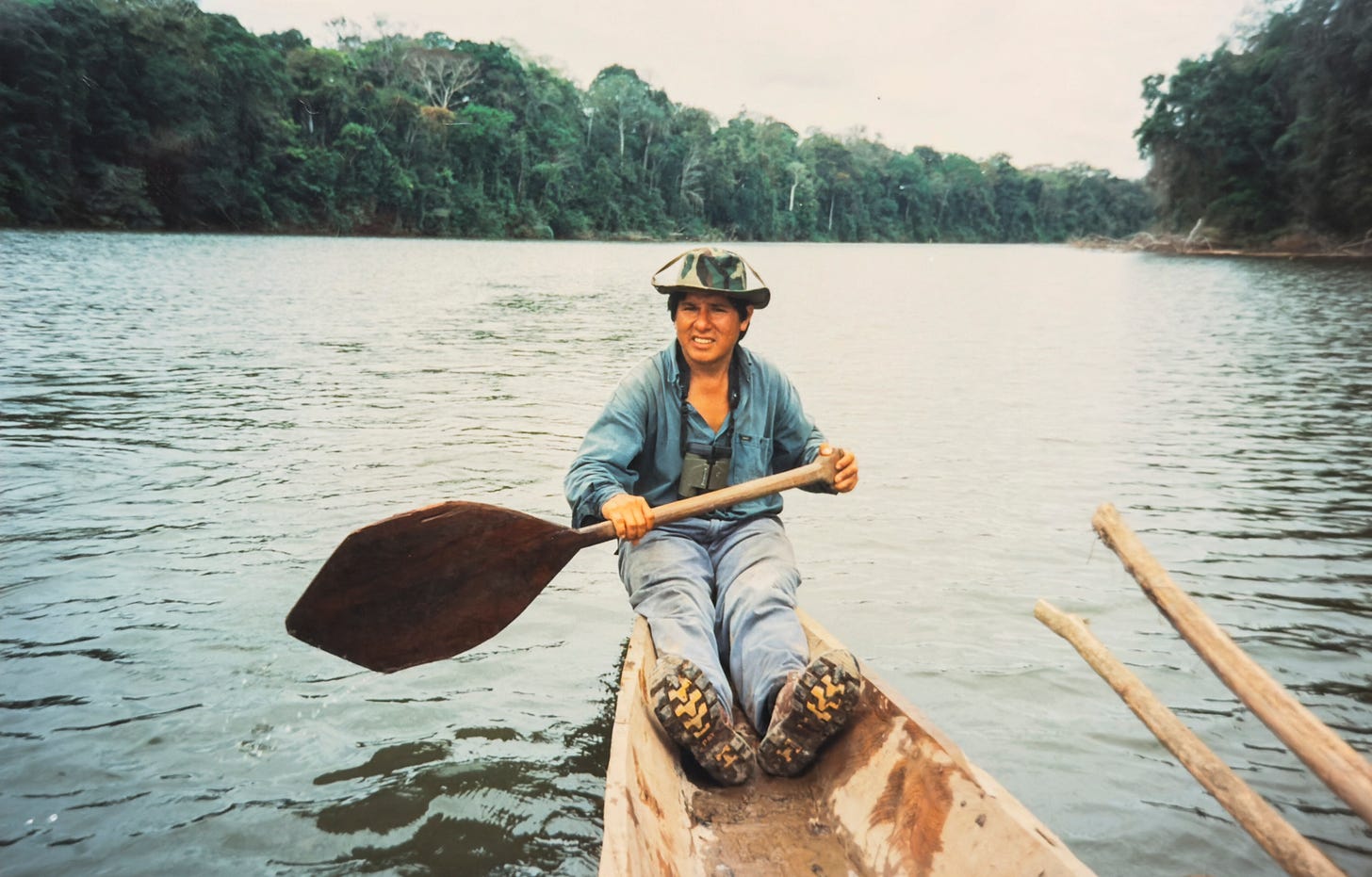
Walter pointed out various spots along the way, mainly the dens the otters used. ‘Madre gare!’ he’d announce with enthusiasm as we passed them, which I think translated roughly to mother station. There were several, all tucked above the water line and just visible in the undergrowth. There were also a couple of latrines that we could make out with our noses; areas of smoothed wet mud under the bushes, where the otters would apparently stop to mark their territory. They stank, not surprisingly, of rotting fish and shit.
One hundred and fifty or so yards from the end of the oxbow we noticed large ripples breaking out from under the bushy edge. We slowed the boat and watched with binoculars as their intensity increased. We assumed it to be otters, and a second or two later this was confirmed when a loud screech broke the silence. It was a fierce call, a cross between a horse whinnying and a drowning cat. Another call followed, and then, about twenty feet from the bushes, an otter’s head popped up out of the water. It was soon joined by another and then a third, and within a few moments we were watching seven otters. They bunched together as they swam in our direction, with just the tops of their heads proud of the water.
Mike and Walter steadied the boat, turning it to face them, and I readied my camera just as they dived and vanished beneath the surface. After forty or so seconds they broke the water in front of us, one at first and then all of them. They continued towards us until they noticed our boat and stopped abruptly, snorting at us and spy-hopping, trying to figure out what we were. Overcome with inquisitiveness they came closer, lifting their necks high out of the water, moving at us like a pack of cobras. When they realised they’d got too close, they suddenly bolted apart, splashing beneath the surface. A few seconds later they all popped up again, circling the boat, huffing and eyeing us with great suspicion.
They were utterly endearing – comically bug-eyed and ugly, their cheeks and eyebrows shocked with oversized whiskers. Their muzzles were broad and expressive, and their heads thickset and large, perhaps the same size as a spaniel’s. Beautifully marked cream-coloured bibs stretched from their chins down to their bellies, uniquely blotched with the brown of their bodies. We sat quiet and still, gently throwing excited smiles at each other as they inspected us from an arm’s length away, diving and bobbing their heads around while continuing to huff in displeasure. After a minute they lost interest and moved on. We let them put some distance between us, then turned our boat and gently followed them.
We watched the family fish for about an hour in the bushes along the lake edge, where they splashed around chasing small fish. They moved with an intensity I hadn’t seen in otters before, pausing only to frantically eat; gripping their fish about its body with their huge front paws and munching it in entirety from the head down. I saw one sub-adult eat a fish so fast that it threw the whole thing back up and had to start again.
It was hard to keep track of them through my lens as they worked along the dark tangle of the overhang, but eventually they moved out into open water and began hunting a shoal of fish in the middle of the lake, their bubble trails revealing their location. We couldn’t see what was going on beneath the surface as the water was brown and murky, but it appeared they were corralling the shoal as the water churned excitedly with terrified fish attempting to leap free. The otters would porpoise out every thirty or forty seconds to grab some air, sometimes together, then dive and separate through the shoal. When one larger adult erupted out of the water with a fish flapping in its mouth, two other smaller otters burst out alongside it, shrieking loudly as they aggressively tried to snatch the prize.
This pursuit went all the way ashore until the larger otter got out on a log and began eating. We drifted the boat towards it so I could shoot the interaction. The smaller otters, which Walter explained were last year’s offspring, got out onto the log to harry the adult with ear-piercing shrieks an inch or so from its face, while at the same time lunging at the fish, trying to steal it. Despite the adult aggressively guarding its meal it was eventually forced to give up, dropping the fish and swimming off, leaving the two cubs to have an explosive fight in the water, both their jaws clamped around the fish’s tail section.
The otters were astonishingly effective and voracious hunters. They’d eat a whole large fish and then go straight back out into the lake and grab another. Walter explained that each otter needed nine pounds of fish a day, which seemed an extraordinary amount. Later on, when they’d exhausted themselves and climbed out onto a fallen tree to nap, I could see why. They were huge, the adult male perhaps six feet long, the others not much shorter. Everything about them was like a cartoon exaggeration of an otter. Their paddle-shaped webbed feet were so large that they looked completely ungainly as they walked up the tree trunk. Their tails were a third of their body length and flat, more rudder-like than the otters I’d worked with back home, and their bodies were long and lithe, stretched with fur coats so smooth and thin that their frame and tight muscles rippled as they moved.
We hung back in the boat as the seven wet otters dried out in the sun. They lay pressed up against each other, some curled together, some nose to tail. The adult male remained alone, basking on his back with his paws in the air. Walter pointed out the mother, ‘Juanita’. She was paler than the others, with an obvious lump on her head, possibly from a botfly or the scar of an old wound, and she sported an impressive array of dangling nipples. I asked Walter if she might have cubs, but he explained that it was unlikely, as they had yearlings and only bred every two years. I was a bit deflated. I really needed cubs for the film, as without them we couldn’t tell the full story.
We followed the otters all afternoon while they fished and napped. They were difficult to film as they moved so fast and frenetically, the majority of the time underwater, but I enjoyed the challenge of keeping up with them through my lens. They often moved together in perfect synchrony with the grace of a single animal, diving together and emerging together. How they kept such perfect track of each other in the depths of the murk remained a mystery, but mysteries are often what make animals more attractive.
As the otters hunted, they seemed to take with them a caravan of birds, like a little moving ecosystem. Numerous species of egrets and herons would land in the shallows next to them, grabbing the small fish escaping in the chaos kicked off by the otters. Neotropical cormorants would skirt the edge of the family group as the otters hunted, grabbing larger fish in the turmoil, which they’d swallow headfirst and whole. Some fish were so large and guarded with sharp back-facing fins that the cormorants struggled to ingest them, and they’d lurch comically around in the water, their necks wriggling and writhing as they forced the fish down.
We followed the otters the entire length of the lake that first day. By early evening they’d stopped fishing and appeared to be moving with purpose. Walter suggested that they were shifting dens for the night. We followed at a distance, keeping track of them as they swam in the shallows of the overhang. The light was beginning to fade and I was about to start packing up, when from the darkness beneath a large bush we heard a snort, quickly followed by an explosion of water. ‘Caiman!’ whispered Walter urgently. The bush suddenly lurched violently with another loud splash. I turned my lens towards the otters but couldn’t see them among the tangle. Mike and Walter hurriedly rowed the boat forward so I could get a better view.
As we cleared a curtain of dense creepers, a hole appeared in the vegetation and I caught sight of the flat black body of a caiman. She was huge, perhaps eleven or twelve feet long. The otters were right on her, surrounding her, snorting aggressively and apparently tormenting her. She hissed ominously and threw her mouth open to present an array of dagger-sharp teeth to them. They seemed nervously excited and taunted her more, moving boldly in, forcing her to sink back against the bank defensively. Juanita went in so close she was almost kissing her on the nose. The caiman lurched her head round trying to grab Juanita but she was too fast and leapt clear; then she went straight back in, like a mongoose harrying a cobra. ‘One’s going for the tail,’ whispered Mike.
I spun the camera down the length of the caiman to the adult male, who was sneaking up behind. As he bit down on the scutes of her tail, the whole bush erupted and the caiman launched herself clear, almost running across the surface until she hit deeper water and instantly sunk. One of the otters must have then bitten her from beneath as she burst to the surface, with another otter leaping over her back, causing her to spin and thrash in fury as she tried to fend them off. She surfaced again briefly, hissing with open jaws as she moved out into the lake, the otters tormenting her from behind, until she had been sufficiently flushed from the shallows. The otters regrouped and carried on to bed, as if nothing had happened.
Over the following weeks we saw many similar interactions and learned to get ahead of the otters, to spot the caiman before they did, so I could be prepared with my camera. The relationship between these two top predators was unexpected and I knew it would bring an essential lift of drama and tension to the film. That evening on the long row back to camp, watching the bat hawks hunting along the treetops and listening to the sounds of the night creatures take over from those that the moon had sent to bed, we buzzed with excitement at what the following day would bring.
Here's a link to a bit from a film Hector and I shot many years later on Cocha Salvador
In the next instalment I behave like a total dickhead.




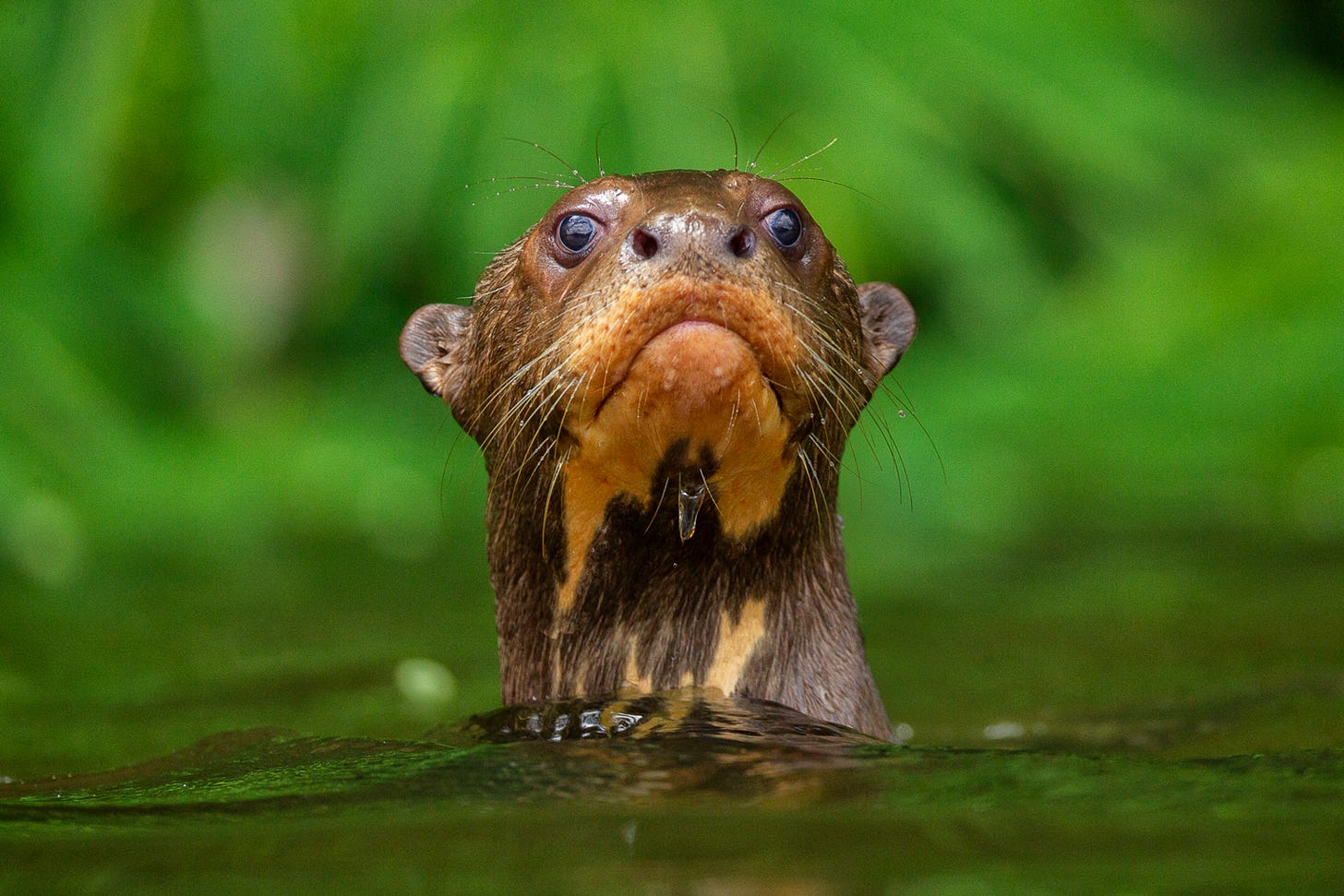
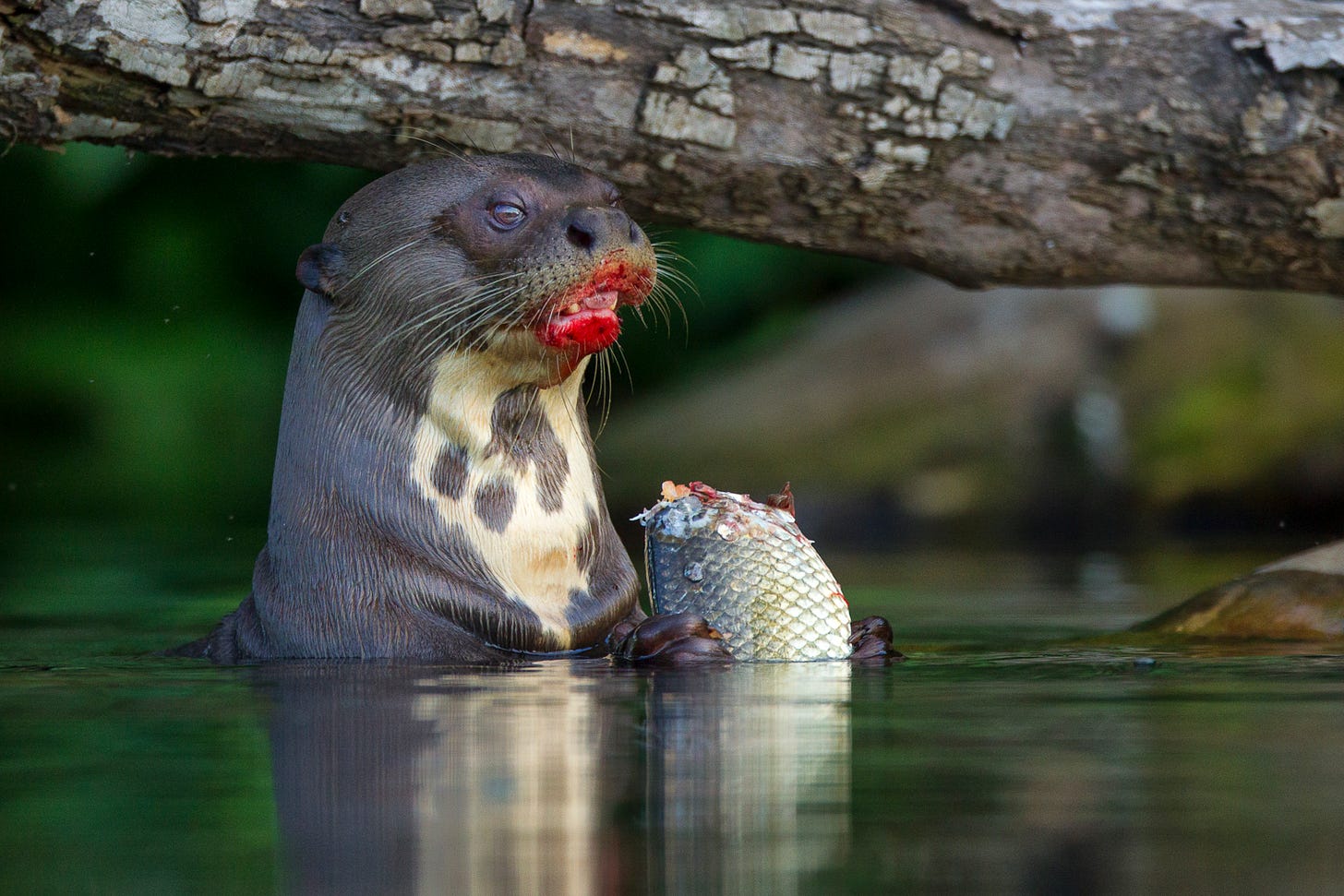
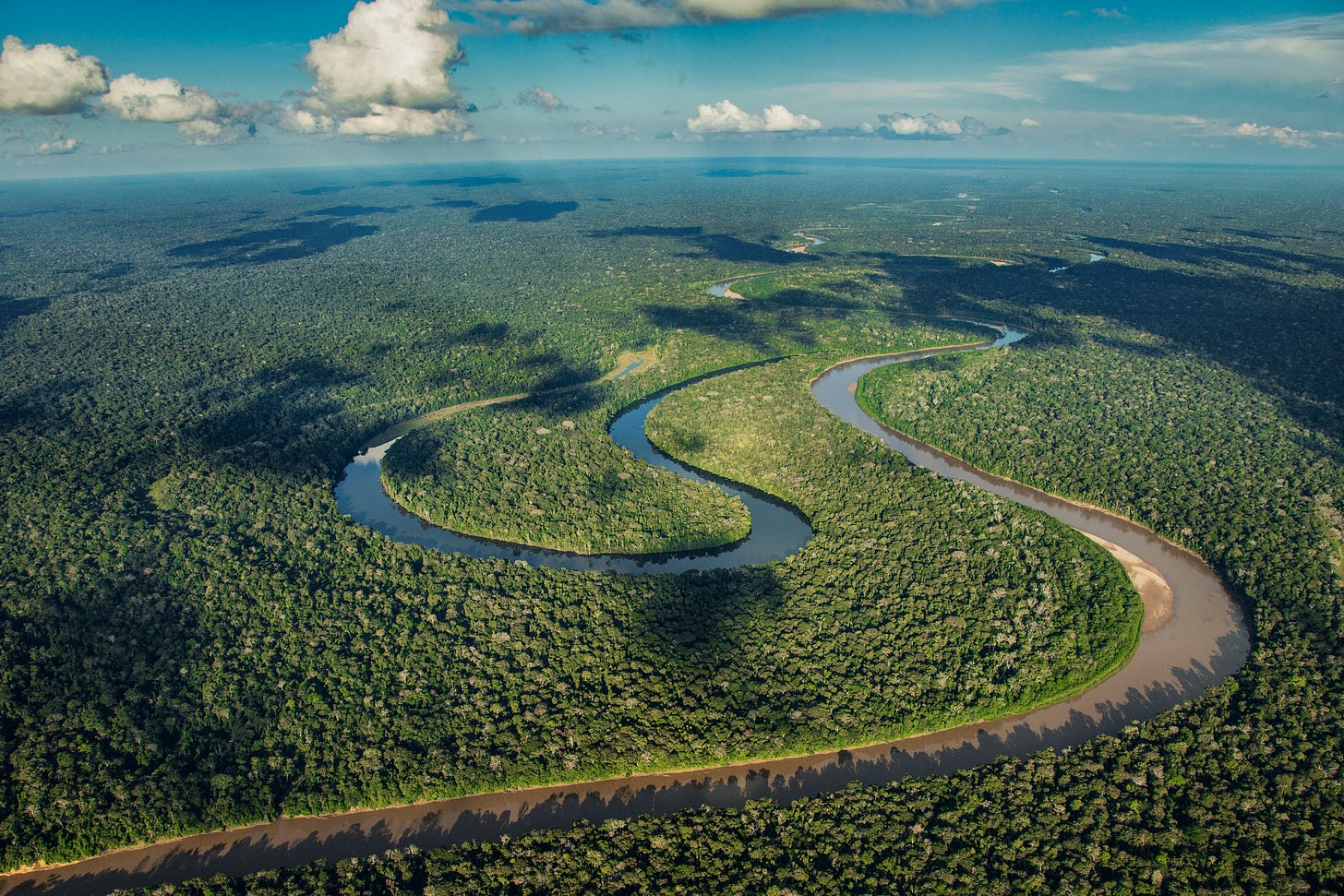
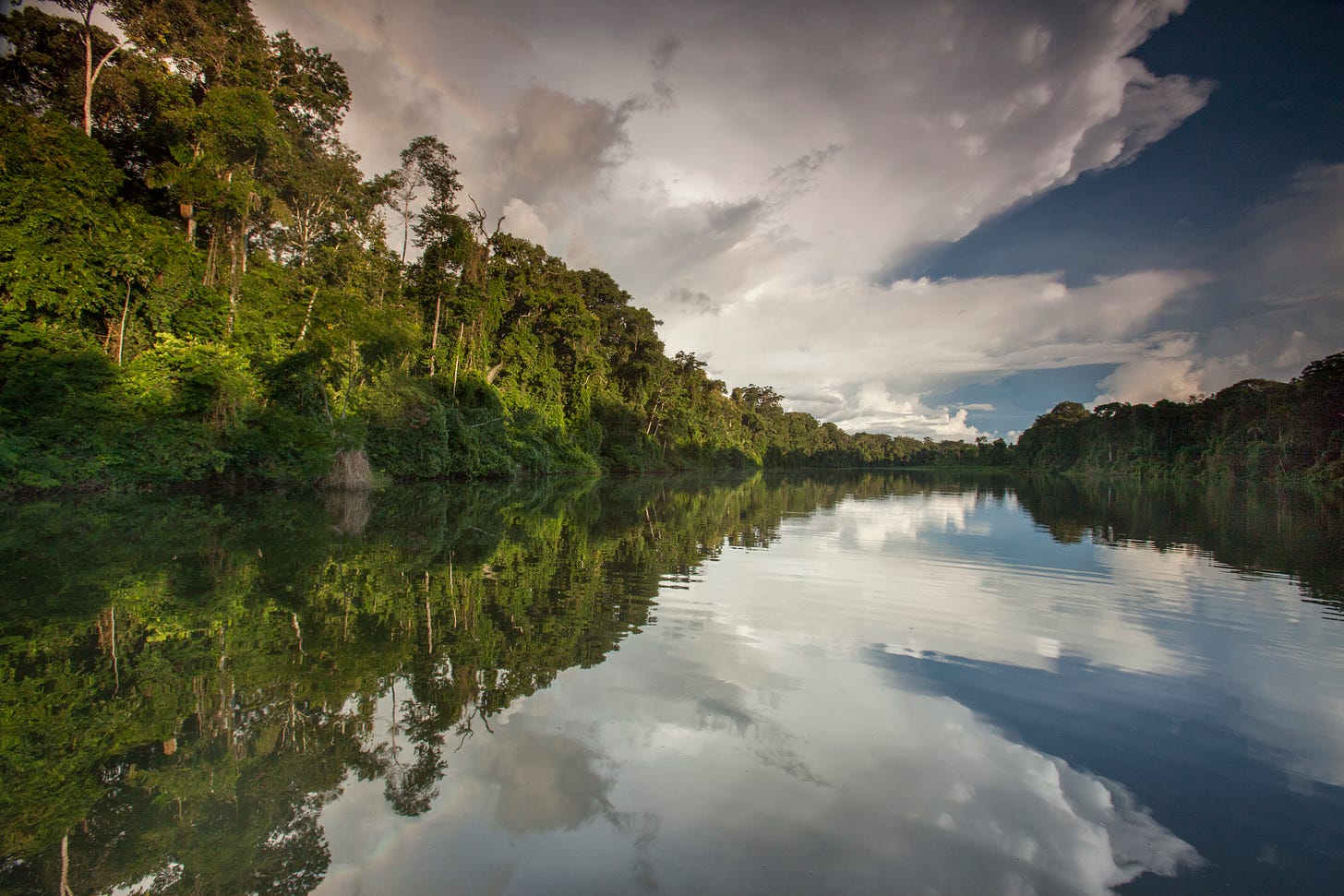

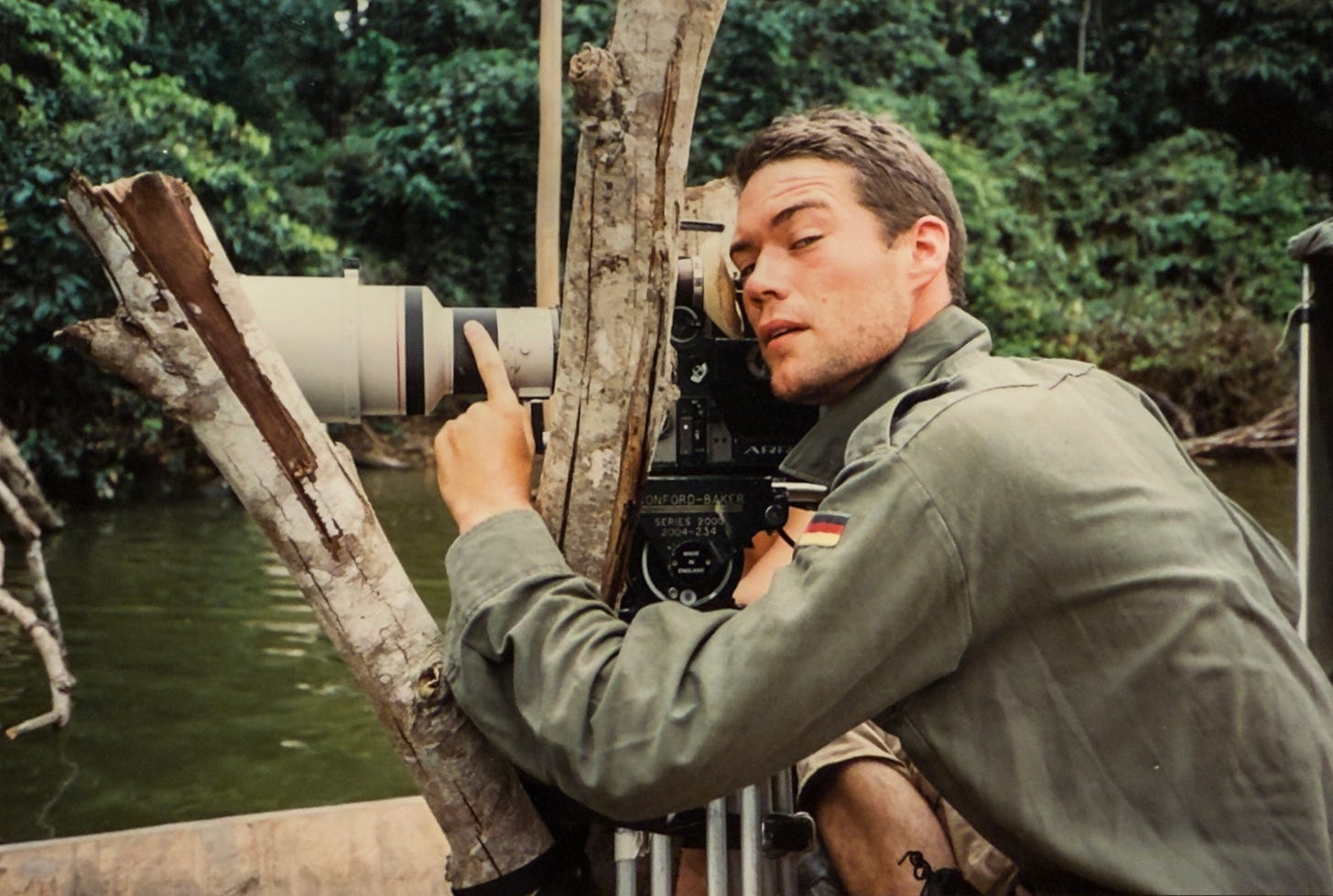
A fantastic chapter! I've heard of North American River Otters attacking alligators in groups. The Giant Otters are terrifying to watch, so big and fast and deadly. Thanks for sharing the video, as well!